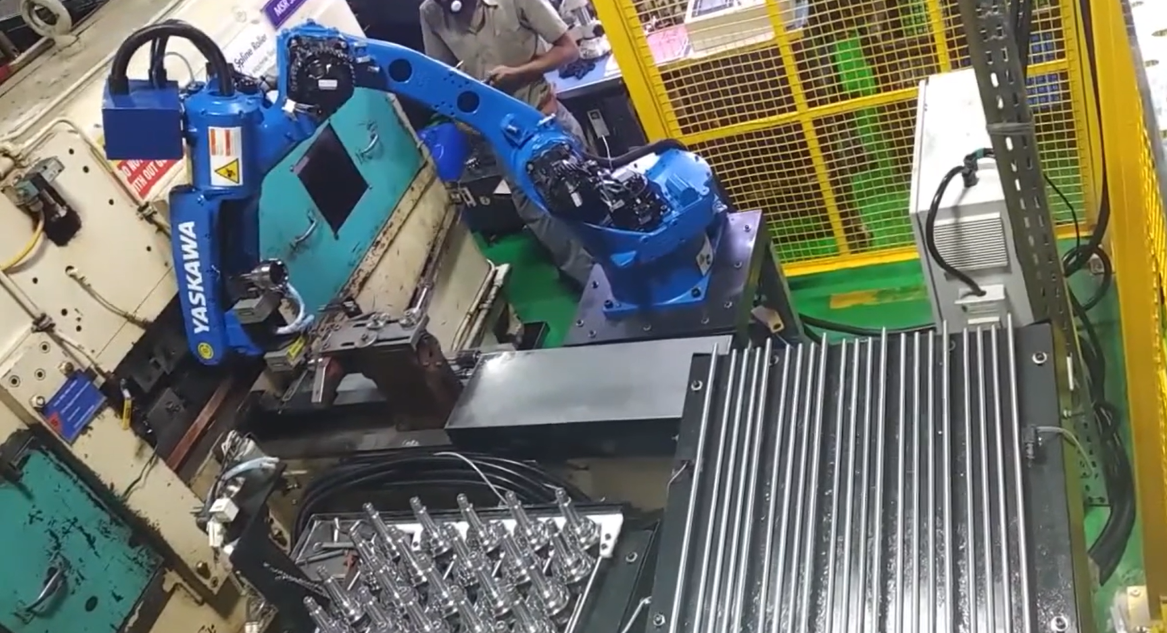
07 Jul Why machine tending is the gateway to lights-out manufacturing
Why machine tending is the gateway to lights-out manufacturing
As manufacturers strive for higher efficiency and lower operating costs, lights-out manufacturing—where production runs without human intervention—has become a strategic goal. One of the most critical enablers of this vision is machine tending automation.
Machine tending involves the automated loading and unloading of parts in CNC machines, lathes, mills, and other industrial equipment. Traditionally a manual task, this process is now increasingly handled by industrial robots equipped with grippers, sensors, and smart controls. By automating this essential yet repetitive function, manufacturers can ensure continuous machine operation—even during off-hours—thus laying the groundwork for a fully autonomous production floor.
Automated machine tending reduces the dependency on human operators, eliminates downtime during shift changes, and minimizes errors caused by fatigue or inconsistency. It not only boosts productivity but also improves workplace safety by keeping workers away from hazardous or tedious tasks.
Moreover, machine tending systems can be easily integrated with vision inspection tools and data logging systems to ensure consistent quality and enable real-time monitoring. This capability is vital for achieving the reliability and traceability required in lights-out environments.
In short, automating machine tending is often the first and most impactful step toward lights-out manufacturing. It bridges the gap between human-dependent processes and fully autonomous operations, making it a foundational investment for future-ready manufacturing.
Why Machine Tending is the Gateway to Lights-Out Manufacturing
As the manufacturing world continues to evolve, the idea of lights-out manufacturing—where production continues autonomously without human presence—has transitioned from futuristic vision to practical reality. Central to this transformation is machine tending, the automation of loading and unloading tasks in manufacturing processes. While lights-out manufacturing involves a range of technologies, machine tending is often the first and most essential step toward realizing it.
What is Machine Tending?
Machine tending refers to the process of loading raw materials into machines, initiating operations, and unloading finished parts. It typically applies to CNC machines, injection molding machines, presses, lathes, mills, and other industrial equipment. When automated using robotic arms, sensors, and vision systems, this process becomes highly efficient, accurate, and capable of running 24/7 without the need for manual intervention.
Why It’s the Gateway to Lights-Out Manufacturing
1. Enables Continuous Operation
A major barrier to achieving lights-out manufacturing is the need for human workers to perform repetitive machine tasks. Automated machine tending eliminates this dependency, allowing production to continue seamlessly during nights, weekends, or holidays. This significantly increases machine utilization and throughput.
2. Reduces Downtime
Manual operations are subject to delays—shift changes, breaks, absenteeism, or fatigue. Robotic machine tending ensures that machines are always fed with materials and unloaded promptly, minimizing idle time and improving operational efficiency.
3. Improves Consistency and Quality
Human operators can make mistakes due to fatigue or oversight. Robots, on the other hand, maintain high precision and repeatability. They ensure that each part is loaded and handled with consistent care, reducing defects and improving product quality.
4. Addresses Labor Shortages
With growing difficulty in hiring and retaining skilled workers, especially for repetitive or physically demanding tasks, automation offers a practical solution. Machine tending robots can take over routine jobs, allowing existing employees to focus on more value-added roles such as programming, quality assurance, or system supervision.
5. Supports Data-Driven Manufacturing
Modern machine tending systems can integrate with vision inspection tools, IoT sensors, and software platforms. This makes it easier to monitor operations remotely, collect production data in real time, and detect any issues before they escalate—key features required in a lights-out factory.
Building the Foundation for Automation
Machine tending doesn’t require a full factory overhaul. It can be implemented in stages, making it ideal for companies looking to begin their automation journey. Once in place, machine tending becomes the backbone for other lights-out capabilities such as automated inspection, tool change, in-process quality control, and robotic material handling.
Real-World Impact Across Industries
Industries such as aerospace, automotive, electronics, and medical device manufacturing have already seen major benefits from automating machine tending. Even small and mid-sized manufacturers are embracing it to stay competitive and meet high production demands with fewer resources.
Conclusion
Machine tending is not just an automation solution—it is the gateway to a smarter, leaner, and more autonomous manufacturing future. By removing the need for human intervention in repetitive processes, it enables 24/7 production, improves efficiency, and sets the stage for full-scale lights-out manufacturing. As technology becomes more affordable and easier to integrate, now is the perfect time for manufacturers to explore machine tending as a strategic step toward the factory of the future.

No Comments